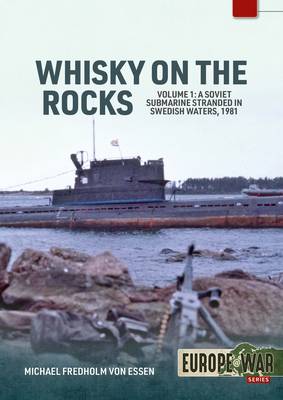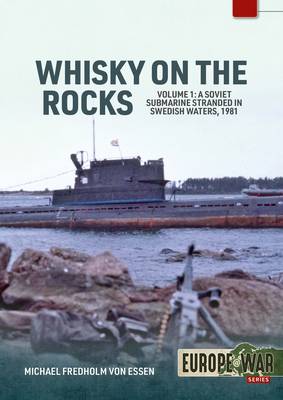
- Retrait gratuit dans votre magasin Club
- 7.000.000 titres dans notre catalogue
- Payer en toute sécurité
- Toujours un magasin près de chez vous
- Retrait gratuit dans votre magasin Club
- 7.000.0000 titres dans notre catalogue
- Payer en toute sécurité
- Toujours un magasin près de chez vous
Whiskey on the Rocks Volume 1
A Soviet Submarine Stranded in Swedish Waters, 1981
Michael Fredholm Von Essen
41,95 €
+ 83 points
Description
This book describes and analyses the events surrounding the Soviet Navy Whiskey-class submarine of the Baltic Fleet which ran aground on 27 October 1981 on the south coast of Sweden, close to Naval Base Karlskrona, one of the largest Swedish military bases. The incident triggered a grave diplomatic and military crisis.
Upon discovery, Swedish navy and army units quickly surrounded the submarine, and closed off the immediate area. Surveillance of Sweden's sea and land borders intensified. Swedish intelligence stepped up activities against Soviet Navy activities and communications. A tense diplomatic game began over the fate of the stranded submarine and its crew. The Soviets claimed that the submarine had entered Swedish waters by accident, and demanded that it be allowed to leave without further inspection of the vessel or interrogation of its crew. The Swedes demanded further clarification with regard to the submarine's mission and activities. Meanwhile, Swedish technical intelligence concluded that the submarine carried nuclear weapons, ultimately identified as torpedoes with nuclear warheads. The submarine crew took measures to blow up the submarine, in case Swedish special forces would storm the vessel - a contingency that the Swedish Armed Forces indeed prepared for.
To exacerbate the political and military crisis, Swedish intelligence and naval reconnaissance noted the unannounced arrival of a number of Soviet warships which anchored just outside Swedish territorial waters. The Soviet naval task force, commanded by Vice Admiral Aleksey Kalinin on the destroyer Obraztsovyy eventually consisted of more than ten Soviet warships. In response, Sweden's Prime Minister Thorbjörn Fälldin ordered the Armed Forces to defend the border, should the Soviets attempt a rescue of the stranded submarine.
At the time, the international media saw the incident as evidence of extensive Soviet underwater activities in Swedish waters. The Swedish Armed Forces concluded that the violation was deliberate and part of illegal intelligence collection directed against Sweden. Yet, others argued that the violation was due to incompetence and substandard technical equipment rather than a conscious policy of aggression.
In this book, Michael Fredholm von Essen describes the submarine incident, and presents new research on what happened based on recently declassified Swedish, Soviet, and U.S. military intelligence archival documents. He details the submarine's voyage into Swedish waters and the confrontation between Swedish and Soviet navy and air force elements He also explains the Soviet naval doctrine and fleet organization that formed the background to the submarine incident and indeed the Soviet Union's global naval stance.
Upon discovery, Swedish navy and army units quickly surrounded the submarine, and closed off the immediate area. Surveillance of Sweden's sea and land borders intensified. Swedish intelligence stepped up activities against Soviet Navy activities and communications. A tense diplomatic game began over the fate of the stranded submarine and its crew. The Soviets claimed that the submarine had entered Swedish waters by accident, and demanded that it be allowed to leave without further inspection of the vessel or interrogation of its crew. The Swedes demanded further clarification with regard to the submarine's mission and activities. Meanwhile, Swedish technical intelligence concluded that the submarine carried nuclear weapons, ultimately identified as torpedoes with nuclear warheads. The submarine crew took measures to blow up the submarine, in case Swedish special forces would storm the vessel - a contingency that the Swedish Armed Forces indeed prepared for.
To exacerbate the political and military crisis, Swedish intelligence and naval reconnaissance noted the unannounced arrival of a number of Soviet warships which anchored just outside Swedish territorial waters. The Soviet naval task force, commanded by Vice Admiral Aleksey Kalinin on the destroyer Obraztsovyy eventually consisted of more than ten Soviet warships. In response, Sweden's Prime Minister Thorbjörn Fälldin ordered the Armed Forces to defend the border, should the Soviets attempt a rescue of the stranded submarine.
At the time, the international media saw the incident as evidence of extensive Soviet underwater activities in Swedish waters. The Swedish Armed Forces concluded that the violation was deliberate and part of illegal intelligence collection directed against Sweden. Yet, others argued that the violation was due to incompetence and substandard technical equipment rather than a conscious policy of aggression.
In this book, Michael Fredholm von Essen describes the submarine incident, and presents new research on what happened based on recently declassified Swedish, Soviet, and U.S. military intelligence archival documents. He details the submarine's voyage into Swedish waters and the confrontation between Swedish and Soviet navy and air force elements He also explains the Soviet naval doctrine and fleet organization that formed the background to the submarine incident and indeed the Soviet Union's global naval stance.
Spécifications
Parties prenantes
- Auteur(s) :
- Editeur:
Contenu
- Nombre de pages :
- 98
- Langue:
- Anglais
- Collection :
Caractéristiques
- EAN:
- 9781804518656
- Date de parution :
- 18-09-25
- Format:
- Livre broché
- Format numérique:
- Trade paperback (VS)
- Dimensions :
- 211 mm x 297 mm

Les avis
Nous publions uniquement les avis qui respectent les conditions requises. Consultez nos conditions pour les avis.






